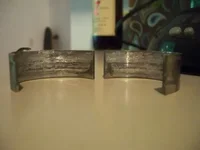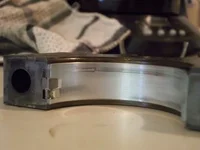I am hoping to finish up installing my new main bearings tonight. I've already gotten the rod bearings installed. Just have 5 mains and then putting everything back together. Does anyone know how long the engine should be run before doing any kind of revving or driving under load, etc? I assume you want to start it up, watch the oil pressure, and let it idle for a bit. But after that?
You are using an out of date browser. It may not display this or other websites correctly.
You should upgrade or use an alternative browser.
You should upgrade or use an alternative browser.
Burn in time for new main & rod bearings?
- Thread starter wildo
- Start date
"I've already gotten the rod bearings installed."
???? I'm confused. Is the crankshaft installed in the block now? Is the engine in the car? I'm asking because I don't think you can replace main bearings with the crankshaft installed.
No break-in is required for new main bearings and rod bearings. They should be prelubed with a good engine assembly lube. Change the oil afer around 100 miles and you should be ok.
Clifton
???? I'm confused. Is the crankshaft installed in the block now? Is the engine in the car? I'm asking because I don't think you can replace main bearings with the crankshaft installed.
No break-in is required for new main bearings and rod bearings. They should be prelubed with a good engine assembly lube. Change the oil afer around 100 miles and you should be ok.
Clifton
Crank until oil pressure is built. Fire motor and let idle until up to operating temp. Run motor at 3K rpms for a few minutes. Let cool down. Repeat and change oil. Then go drive it going to 3-4K rpms and letting it engine brake to pull lots of vacuum. Put a few miles on it. Check things over, change oil and beat the snot out of it.
Thanks guys. Unfortunately, I got in the car and pressed the clutch- it just fell to the floor. Something is wrong here... I think it may be the slave cylinder, but not sure how to test it. Seems like there is NO pressure on it. I can push the slave in and out, and i can seemingly move the throwout bearing fork through a good distance of its swing. I didn't remove the tranny entirely- just exposed about 1" of the flywheel (about a 2-3" opening case-to-case). AHHH!! Not sure what to check now... Thoughts?
(Clifton- certainly wasn't trying to prove you wrong. I throughly enjoy your posts on here. Seems like you know what you are talking about. It was not easy to get the old bearings out, or the new bearings in- but with some luck, I was able to get it.)
(Clifton- certainly wasn't trying to prove you wrong. I throughly enjoy your posts on here. Seems like you know what you are talking about. It was not easy to get the old bearings out, or the new bearings in- but with some luck, I was able to get it.)
I don't know what the hell the problem is. I reached down there and pulled the pedal up, and I was able to build pressure. Perhaps my slave cylinder is just going bad? I'm going to have to research this more. But I just started the car!!!!!!!
Was it working fine before you started tearing apart the engine?
CheeseHelmet
Member
I don't know what the hell the problem is. I reached down there and pulled the pedal up, and I was able to build pressure. Perhaps my slave cylinder is just going bad? I'm going to have to research this more. But I just started the car!!!!!!!
I had the same thing happen to me when I curiously poked the slave cylinder's piston back in further than it normally goes. The pedal just dropped to the floor but it worked as soon as I pulled it back up.
Here's what I think happened: by pulling the tranny back, that pushed the slave cylinder's piston back in more than it would normally go. Upon getting everything back together the slave cylinder's piston probably wasn't touching the clutch release fork. When you pushed the clutch pedal down the first time, the piston moved out as much as it would on a regular stroke but because it was retracted a bit, it just started touching the release fork at the end of the stroke. The pedal stayed on the floor because the release fork couldn't physically push it back. By pulling the pedal up, hydraulic fluid gets sucked back into the system which allows the slave cylinder's piston to push out even further on the second stroke. At this point you can start properly "building pressure".
I hope this makes sense...
TL;DR: I think your clutch's hydraulic system is just fine.
I had the same thing happen to me when I curiously poked the slave cylinder's piston back in further than it normally goes. The pedal just dropped to the floor but it worked as soon as I pulled it back up.
Here's what I think happened: by pulling the tranny back, that pushed the slave cylinder's piston back in more than it would normally go. Upon getting everything back together the slave cylinder's piston probably wasn't touching the clutch release fork. When you pushed the clutch pedal down the first time, the piston moved out as much as it would on a regular stroke but because it was retracted a bit, it just started touching the release fork at the end of the stroke. The pedal stayed on the floor because the release fork couldn't physically push it back. By pulling the pedal up, hydraulic fluid gets sucked back into the system which allows the slave cylinder's piston to push out even further on the second stroke. At this point you can start properly "building pressure".
I hope this makes sense...
TL;DR: I think your clutch's hydraulic system is just fine.
As it were, I pushed in the slave cylinder piston by hand. Ha! Didn't think it would have that result though. I really expected the pedal push to immediately pump it back up.
On a not-so-side note, the car is running GREAT! No more knock! Attached is a pic of the bad connecting rod bearing (#2 cylinder) and also the 1 main bearing that was slightly pitted/scored probably from a metal shaving. Overall, I got REALLY lucky. Note to self- check your oil stupid!!
Attachments
CheeseHelmet
Member
As it were, I pushed in the slave cylinder piston by hand. Ha! Didn't think it would have that result though. I really expected the pedal push to immediately pump it back up.
You'd think they'd put a small spring behind the pedal...
On a not-so-side note, the car is running GREAT! No more knock! Attached is a pic of the bad connecting rod bearing (#2 cylinder) and also the 1 main bearing that was slightly pitted/scored probably from a metal shaving. Overall, I got REALLY lucky. Note to self- check your oil stupid!!
That's awesome, I don't think I'd have ever figured that out. Glad to hear your car is working again!
New Posts and Comments
- Replies
- 5
- Views
- 105
- Replies
- 4K
- Views
- 935K



